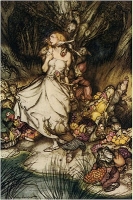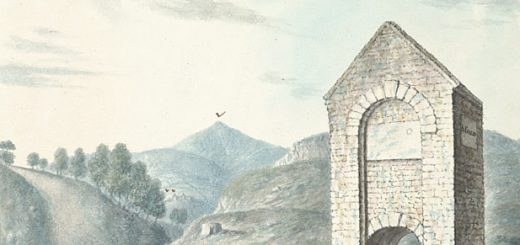The Cerne Abbas Giant
The Cerne Abbas Giant or the ‘Rude Man’ is one of the largest hillfigures in Britain, he (the figure’s gender is beyond doubt) is one of two representations of the human form, the other being the Long Man of Wilmington in East Sussex. The giant, carved in solid lines from the chalk bedrock measures in at 180 feet high, and carries a huge knobbled club, which measures 120 feet in length.
 The first written record of the giant appears in 1751 in a letter by Dorset historian John Hutchins, he suggested that the figure was cut in the mid 1600’s. Another slightly later reference to the figure can be found in the Gentleman’s magazine of 1764, where the figure is described and depicted with a navel, that has long since disappeared. The lack of earlier references is frustrating but does not mean that the figure dates to the 17th century, and its style and proximity to an Iron Age earthwork suggests a much earlier origin.
The first written record of the giant appears in 1751 in a letter by Dorset historian John Hutchins, he suggested that the figure was cut in the mid 1600’s. Another slightly later reference to the figure can be found in the Gentleman’s magazine of 1764, where the figure is described and depicted with a navel, that has long since disappeared. The lack of earlier references is frustrating but does not mean that the figure dates to the 17th century, and its style and proximity to an Iron Age earthwork suggests a much earlier origin.
There are numerous theories as to when and why the giant was created, one of the more popular is that he is the Greek-Roman god Hercules, who is often represented with a club and an animal fur. It has been suggested that the figure was once depicted carrying and animal fur in his left hand. It is possible that worship of Hercules arrived in the early part of the Roman invasion, which was then became amalgamated with a god of a local Celtic tribe. The theory given the most weight by historians is that it was created during the reign of the Emperor Commodus between 180 – 193 AD, he believed himself to be a reincarnation of Hercules and allowed the cult to revive.
Other stories suggest that the monks at the nearby monastery cut the giant as a joke on an Abbott called Thomas Corton, who was expelled from the area for malpractice. This is unlikely but its close proximity to a ecclesiastical house is strange, how could such an obviously pagan symbol have survived for so long? especially through puritanical times and the reformation. It may be that the religious buildings were built close to the giant as a form of amalgamation of the pagan site. This was common practice, and many churches are built on, or near to, sites that were once Pagan religious centres.
Folklore
 According to one tradition, recorded from a farm labourer in the Gentleman’s Magazine, the figure is the representation of a Danish giant who had led an invasion of England from the coast. He had fallen asleep on the side of the hill, and the local villagers had taken advantage of his slumber and cut off his head. They had then drawn around his prone body in the manner of a gigantic police chalk line, to show where he met his doom. However, the chalk figure sometimes rose from the dead on dark nights, to quench his thirst in the local stream, a habit also common to certain standing stones.
According to one tradition, recorded from a farm labourer in the Gentleman’s Magazine, the figure is the representation of a Danish giant who had led an invasion of England from the coast. He had fallen asleep on the side of the hill, and the local villagers had taken advantage of his slumber and cut off his head. They had then drawn around his prone body in the manner of a gigantic police chalk line, to show where he met his doom. However, the chalk figure sometimes rose from the dead on dark nights, to quench his thirst in the local stream, a habit also common to certain standing stones.
The giant’s obvious sexuality and virility was put to use in fertility folk magic. Local women who wanted to conceive would spend a night alone on the hillside – most productively within the confines of his giant phallus, and young couples would make love on the giant to ensure conception.
Sleeping on the giant was also thought to be a good way to ensure a future wedding for unmarried women. Just above the giant’s head is a small Iron Age earthwork which encloses a roughly square piece of land, this is known as the ‘Frying Pan’ or the ‘Trendle’ and it was within this enclosure that the Mayday Maypole was erected during the festival celebrations. Like many traditional village Maypole ceremonies this practice died out in the 19th century.
Directions: Half a mile North of Cerne Abbas, Dorset, the best viewpoint is beside the A352.




Recent Comments